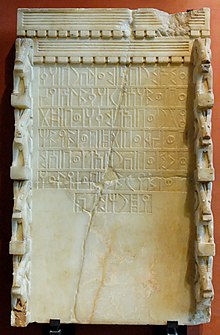| Sabaic | |
|---|---|
| Native to | Yemen |
| Region | Arabian Peninsula |
| Extinct | 6th century |
| Ancient South Arabian | |
| Language codes | |
| ISO 639-3 | xsa |
xsa | |
| Glottolog | saba1279 |

Sabaic, sometimes referred to as Sabaean, was an Old South Arabian language that was spoken between c. 1000 BC and the 6th century AD by the Sabaeans. It was used as a written language by some other peoples of the ancient civilization of South Arabia, including the Ḥimyarites, Ḥashidites, Ṣirwāḥites, Humlanites, Ghaymānites, and Radmānites.[1] Sabaic belongs to the South Arabian Semitic branch of the Afroasiatic language family.[2] Sabaic is distinguished from the other members of the Old South Arabian group by its use of h to mark the third person and as a causative prefix; all of the other languages use s1 in those cases. Therefore, Sabaic is called an h-language and the others s-languages.[3] Numerous other Sabaic inscriptions have also been found dating back to the Sabean colonization of Africa.[4][5]
- ^ Korotayev, Andrey (1995). Ancient Yemen. Oxford: Oxford University Press. ISBN 0-19-922237-1.
- ^ Kogan & Korotayev 1997.
- ^ Nebes, Norbert; Stein, Peter (2008). "Ancient South Arabian". In Woodard, Roger D. (ed.). The Ancient Languages of Syria-Palestine and Arabia (PDF). Cambridge: Cambridge University Press. pp. 145–178. doi:10.1017/CBO9780511486890. ISBN 9780511486890.
- ^ The Athenaeum. J. Lection. 1894. p. 88.
- ^ Radner, Karen; Moeller, Nadine; Potts, Daniel T. (2023-04-07). The Oxford History of the Ancient Near East: Volume V: the Age of Persia. Oxford University Press. p. 353. ISBN 978-0-19-068766-3.